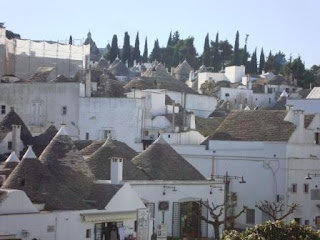There are two concentrations of tulli in Alberobello. The western hill is shown below. A large fraction of the tulli there are either shops or can be rented out by the night, week, or longer. Yes, you can sleep in a trullo if your heart truly desires it.
The trulli on the eastern hill are mostly privately owned. There is a small public park/belvedere on the eastern side from which one can view the western side. The eastern area is behind Amy.
The largest trullo in town is called Trullo Sovrano. It isn't actually all that old, having been initially built in the late 1700's. It was built for the parish priest of the church it is directly behind. What is cool about it is that it is the only double decker trullo in existance. There is conclusive evidence that the building was not built all at once but expanded organically over time. The roof is not one single cone but instead, is a group of melded cones.
Originally, you could walk around on the roof of the trullo as the stairs in the picture below suggest. Windows on the stairway to the second floor reveal small rooftop terraces and walkways. However, the stairs to the top are now blocked and it is clear they don't encourage visitors.
A nifty feature of Trullo Sovrano was this hole in the bedroom wall to the left of the main entrance. It served the dual function of allowing the owner to see who was at their door and, as the shape suggests, to greet them with a gun if they weren't welcome.
The trulli of Alberobello and the Trullo Sovrano are on the UNESCO World Heritage list. A visit, if you happen to be in the area, is well worth the drive.






No comments:
Post a Comment